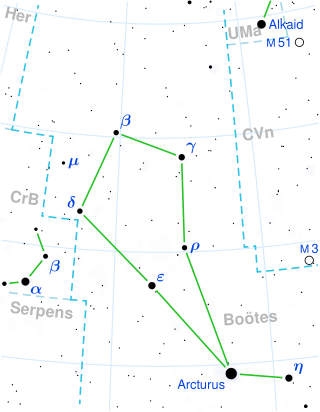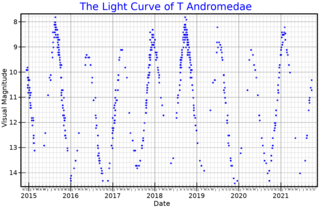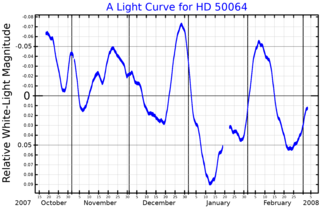
8 Andromedae, abbreviated 8 And, is a probable triple star system in the northern constellation of Andromeda. 8 Andromedae is the Flamsteed designation. It is visible to the naked eye with an apparent visual magnitude of 4.82. Based upon an annual parallax shift of 5.7 mas, it is located about 570 light years from the Earth. It is moving closer with a heliocentric radial velocity of −8 km/s.

63 Andromedae is an Alpha2 Canum Venaticorum variable star in the constellation Andromeda. Its variable star designation is PZ Andromedae. With an apparent magnitude of about 5.6, it is bright enough to be seen by naked eye. Based upon an annual parallax shift of 8.53 mas, it is located 382 light years away.

9 Aurigae is a star system in Auriga (constellation). It has an apparent magnitude of about 5, making it visible to the naked eye in many suburban skies. Parallax estimates made by the Hipparcos spacecraft put it at about 86 light-years from the solar system, although individual Gaia Data Release 3 parallaxes place all three components at 88 light years.

Iota Boötis is a member of a binary star system in the constellation Boötes, approximately 96 light-years from Earth. It has the traditional name Asellus Secundus and the Flamsteed designation 21 Boötis. The companion is HD 234121, a K0 main sequence star.

Phi Cassiopeiae is a multiple star in the constellation Cassiopeia with a combined apparent magnitude of +4.95. The two brightest components are A and C, sometimes called φ1 and φ2 Cas. φ Cas A is an F0 bright supergiant of magnitude 4.95 and φ Cas C is a 7.08 magnitude B6 supergiant at 134".

IC 2391 is an open cluster in the constellation Vela consisting of hot, young, blueish stars, some of which binaries and one of which is a quadruple. Persian astronomer A. a.-R. al-Sufi first described it as "a nebulous star" in c. 964. It was re-found by Abbe Lacaille and cataloged as Lac II 5.

T Andromedae is a variable star of the Mira type in the constellation Andromeda. Like all the stars of this kind, T And is a cool asymptotic giant branch star of spectral type M4e-M7.5e. Its brightness varies periodically, completing a cycle in 281 days. The peak luminosity, however, is different every variability cycle, but can reach a peak magnitude mv=7.70.

WR 7 is a Wolf–Rayet star in the constellation of Canis Major. It lies at the centre of a complex bubble of gas which is shocked and partially ionised by the star's radiation and winds.
HAT-P-4 is a wide binary star consisting of a pair of G-type main-sequence stars in the constellation of Boötes. It is also designated BD+36°2593.
HD 175167 is a star with an exoplanet companion in the southern constellation of Pavo. It is too faint to be visible with the naked eye at an apparent visual magnitude of 8.01. The system is located at a distance of 232 light-years from the Sun based on parallax measurements, and it is drifting further away with a radial velocity of 5 km/s. It shows a high proper motion, traversing the celestial sphere at an angular rate of 0.190 arcsec yr−1.

HD 50064 is a blue supergiant located in the constellation of Monoceros, easy to see with small telescopes.

31 Orionis is a binary star system in the equatorial constellation of Orion, located near the bright star Mintaka. It is visible to the naked eye as a faint, orange-hued point of light with a baseline apparent visual magnitude of 4.71. The distance to this system is approximately 490 light years away based on parallax, and it is drifting further away with a mean radial velocity of +6 km/s.

1 Puppis is a single star in the southern constellation of Puppis. It lies in the northern part of the constellation at a distance of about 790 ly, east of Aludra in Canis Major and just north of the white supergiant, 3 Puppis. This object is visible to the naked eye as a faint, red-hued star with an apparent visual magnitude of 4.59. It is moving further from the Earth with a heliocentric radial velocity of +32.4 km/s.

RX Telescopii is an irregular variable star in the constellation Telescopium. It has a maximum magnitude of 6.45 and a minimum magnitude 7.47. It is a red supergiant with a spectral type of M3Iab, indicating the star is an intermediate-size luminous supergiant star.

WR 42e is a Wolf–Rayet star in the massive H II region NGC 3603 in the constellation of the Carina. It is around 25,000 light-years or 7,600 parsec from the Sun. WR 42e is one of the most massive and most luminous stars known.

V520 Persei is a blue supergiant member of NGC 869, one of the Perseus Double Cluster open clusters. It is an irregular variable star. At a magnitude of 6.55, V520 Persei is the brightest member in either NGC 869 or NGC 884, although the brighter HD 13994 lies in the foreground along the same line of sight.

TYC 8998-760-1 is a young star, about 27 Myr old, located 310 light years away in the constellation of Musca, with a mass 1.00±0.02 times the Sun.

R Puppis is a variable star in the constellation Puppis. It is a rare yellow hypergiant and a candidate member of the open cluster NGC 2439. It is also an MK spectral standard for the class G2 0-Ia.

RS Sagittarii is an eclipsing binary star system in the southern constellation of Sagittarius, abbreviated RS Sgr. It is a double-lined spectroscopic binary with an orbital period of 2.416 days, indicating that the components are too close to each other to be individually resolved. The system has a combined apparent visual magnitude of 6.01, which is bright enough to be faintly visible to the naked eye. During the primary eclipse the brightness drops to magnitude 6.97, while the secondary eclipse is of magnitude 6.28. The distance to this system is approximately 1,420 light years based on parallax measurements.

HD 33541, also known as HR 1683, is a white-hued star located in the northern circumpolar constellation Camelopardalis. It has an apparent magnitude of 5.83, making it faintly visible to the naked eye. Gaia DR3 parallax measurements imply a distance of 358 light years and it is currently receding with a heliocentric radial velocity of 9.9 km/s. At its current distance HD 33541's brightness is diminished by 0.16 magnitudes due to interstellar extinction and it has an absolute magnitude of +0.58.

















